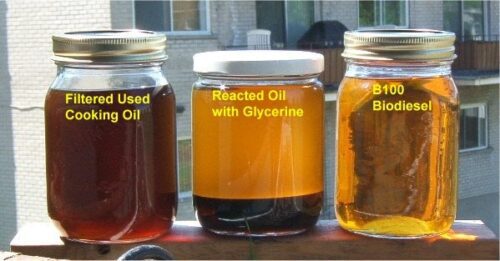Used Cooking Oil and Biodiesel: Why These Two Make a Good Pair
The Potential of Indonesia’s Used Cooking Oil for Biodiesel
One of the benefits of Used Cooking Oil is none other than to make biodiesel, and this is very strategic for Indonesia who has quite ambitious biofuel policies in the world.
Back in 2018, all diesel fuel used for land vehicles must have 20% bio-content. This year, the target increases to 30%.
Then, a study by the International Council on Clean Transportation (ICCT) entitled “Potential Economic, Health and Greenhouse Gas Benefits of Incorporating Used Cooking Oil into Indonesia’s Biodiesel” reported that Indonesia’s UCO potential is as much as 1.64 billion liters per year.

To start with, cooking oil consumption is high in Indonesia even though there is not yet a systematic effort to collect and repurpose UCO. Some have been collected and turned into biodiesel, but many others, especially at the household scale, were disposed of into drainage and even soil.
In fact, according to the ICCT study, UCO collection could be expanded to cover all urban restaurants and other sources that produce many UCOs, which could make meaningful contributions to Indonesia’s goal in terms of biofuel blending.



In numbers, the potential for UCO collection from public places such as restaurants, schools, and hotels in urban areas amount to 175 million liters, which equals to 121 million liters of biodiesel.
If expanded to the household collection, the total numbers could rise to as much as 1,638 billion liters of used cooking oil, which is the equivalent of 1,261 billion liters of biodiesel.
Benefits of Using UCOs for Biodiesel compared to Palm Oil
To give a little background, according to the ICCT study, the biodiesel that Indonesia uses to meet its national mandate comes exclusively from palm oil.
On the other hand, in the last few decades, oil palm expansion in Indonesia has been one of the major contributors to deforestation and biodiversity losses, and other ecological disasters.



When taking into consideration the number of CO2 emissions that were generated by palm oil plantations, it was safe to say that Indonesia’s biofuel policies are counterproductive to its goal of reducing CO2 emissions by 26% relative to a business-as-usual scenario by 2020 (Government of Indonesia, 2016).
Therefore, generating biodiesel from certain types of waste, in this case used cooking oil, can be a much more environmentally-friendly alternative compared to using new oil (namely palm oil).
If Indonesia could produce 1.2 to 1.6 billion liters of biodiesel from UCO, then Indonesia could replace 45% of its current consumption of palm biodiesel with waste oil.
This means saving an equivalent of 6 million tonnes of carbon dioxide annually, saving 3.6 trillion Rupiah from biodiesel subsidy, as well as sparing 321,000 hectares of forests from palm oil expansion.
The Process of Converting Used Cooking Oil into Biodiesel
The process of making biodiesel from used cooking oil is not that complicated, at least in theory.
- Purification and Refinement: After used cooking oil is collected, the next step is to filter the oil to remove any substances such as meat scraps, water, crumbs, and other leftovers. Used cooking oil also contains a high amount of free fatty acids (FFAs). These FFAs need to be pre-treated before it’s ready to be turned into biofuel
- Transesterification: In this process, an ester is combined with alcohol. In this case, the ester is the used cooking oil and combined with methyl alcohol or methanol. Then a small amount of catalyst is added to start the chemical reaction (usually sodium chloride).



The end results will be methyl ester (the technical term for biodiesel fuel) and glycerin. While the biofuel is ready to use. the glycerin is further separated out, which can be used as an ingredient in cleaning products, cosmetics, and pharmaceuticals.
If you want to make sure that your Used Cooking Oil is managed responsibly instead of ending up polluting the environment, you can send your UCO to Waste4Change through the Send Your Waste program.
Do not forget to pack it in a sealed and safe container and send it using delivery services that cater to liquid items delivery. Waste4Change will happily convert your UCO into biodiesel.



References:
https://katadata.co.id/jeany/infografik/5f2b703dc8b8b/manfaat-minyak-jelantah-untuk-biodiesel



